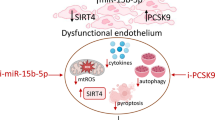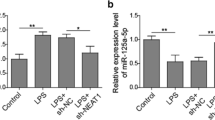Abstract
Background
Sepsis is a systemic inflammatory response syndrome characterized by persistent inflammation and immunosuppression, leading to septic shock and multiple organ dysfunctions. Ubiquitin-specific peptidase 10 (USP10), a deubiquitinase enzyme, plays a vital role in cancer and arterial restenosis, but its involvement in sepsis is unknown.
Objective
In this study, we investigated the significance of USP10 in lipopolysaccharide (LPS)-stimulated macrophages and its biological roles in LPS-induced sepsis.
Methods
Lipopolysaccharides (LPS) were used to establish sepsis models in vivo and in vitro. We use western blot to identify USP10 expression in macrophages. Spautin-1 and USP10-siRNA were utilized for USP10 inhibition. ELISA assays were used to assess for TNF‐α and IL-6 in vitro and in vivo. Nuclear and cytoplasmic protein extraction and Confocal microscopy were applied to verify the translocation of NF‐κB. Mechanically, co-immunoprecipitation and rescue experiments were used to validate the regulation of USP10 and NEMO.
Results
In macrophages, we found that LPS induced USP10 upregulation. The inhibition or knockdown of USP10 reduced the pro‐inflammatory cytokines TNF-α and IL-6 and suppressed LPS‐induced NF‐κB activation by regulating the translocation of NF‐κB. Furthermore, we found that NEMO, the regulatory subunit NF-κB essential modulator, was essential for the regulation of LPS-induced inflammation by USP10 in macrophages. NEMO protein evidently interacted with USP10, whereby USP10 inhibition accelerated the degradation of NEMO. Suppressing USP10 significantly attenuated inflammatory responses and improved the survival rate in LPS-induced sepsis mice.
Conclusions
Overall, USP10 was shown to regulate inflammatory responses by stabilizing the NEMO protein, which may be a potential therapeutic target for sepsis-induced lung injury.








Similar content being viewed by others
Data availability
The datasets used and analyzed during the current study are available from the corresponding author on reasonable request.
References
van der Poll T, van de Veerdonk FL, Scicluna BP, Netea MG. The immunopathology of sepsis and potential therapeutic targets. Nat Rev Immunol. 2017;17(7):407–20.
Zhang Q, Lenardo M, Baltimore D. 30 years of NF-κB: a blossoming of relevance to human pathobiology. Cell. 2017;168:37–57.
Hayden M, Ghosh S. NF-κB, the first quarter-century: remarkable progress and outstanding questions. Genes Dev. 2012;26(3):203–34.
Harhaj EW, Dixit VM. Regulation of NF-kappaB by deubiquitinases. Immunol Rev. 2012;246(1):107–24.
Miyamoto S. Nuclear initiated NF-κB signaling: NEMO and ATM take center stage. Cell Res. 2011;21(1):116–30.
McCool K, Miyamoto S. DNA damage-dependent NF-κB activation: NEMO turns nuclear signaling inside out. Immunol Rev. 2012;246(1):311–26.
Audry M, Ciancanelli M, Yang K, Cobat A, Chang H, Sancho-Shimizu V, et al. NEMO is a key component of NF-κB- and IRF-3-dependent TLR3-mediated immunity to herpes simplex virus. J Allergy Clin Immunol. 2011;128(3):610-7.e1-4.
Tomar D, Singh R. TRIM13 regulates ubiquitination and turnover of NEMO to suppress TNF induced NF-κB activation. Cell Signal. 2014;26(12):2606–13.
Xing J, Weng L, Yuan B, Wang Z, Jia L, Jin R, et al. Identification of a role for TRIM29 in the control of innate immunity in the respiratory tract. Nat Immunol. 2016;17(12):1373–80.
Shen M, Schmitt S, Buac D, Dou Q. Targeting the ubiquitin-proteasome system for cancer therapy. Expert Opin Ther Targets. 2013;17(9):1091–108.
Rivkin E, Almeida S, Ceccarelli D, Juang Y, MacLean T, Srikumar T, et al. The linear ubiquitin-specific deubiquitinase gumby regulates angiogenesis. Nature. 2013;498(7454):318–24.
Lee C, Kim S, Hwang G, Song J. Deubiquitinases: modulators of different types of regulated cell death. Int J Mol Sci. 2021;22(9):4352.
Luo P, Qin C, Zhu L, Fang C, Zhang Y, Zhang H, et al. Ubiquitin-specific peptidase 10 (USP10) inhibits hepatic steatosis, insulin resistance, and inflammation through Sirt6. Hepatology (Baltimore, MD). 2018;68(5):1786–803.
Liao Y, Liu N, Xia X, Guo Z, Li Y, Jiang L, et al. USP10 modulates the SKP2/Bcr-Abl axis via stabilizing SKP2 in chronic myeloid leukemia. Cell Discov. 2019;5:24.
Tang X, Jiang H, Lin P, Zhang Z, Chen M, Zhang Y, et al. Insulin-like growth factor binding protein-1 regulates HIF-1α degradation to inhibit apoptosis in hypoxic cardiomyocytes. Cell Death Discov. 2021;7(1):242.
Gilmore T. Introduction to NF-kappaB: players, pathways, perspectives. Oncogene. 2006;25(51):6680–4.
Perkins N. Integrating cell-signalling pathways with NF-kappaB and IKK function. Nat Rev Mol Cell Biol. 2007;8(1):49–62.
Niu J, Shi Y, Xue J, Miao R, Huang S, Wang T, et al. USP10 inhibits genotoxic NF-κB activation by MCPIP1-facilitated deubiquitination of NEMO. EMBO J. 2013;32(24):3206–19.
Robb CT, Regan KH, Dorward DA, Rossi AG. Key mechanisms governing resolution of lung inflammation. Semin Immunopathol. 2016;38(4):425–48.
Mevissen TET, Komander D. Mechanisms of deubiquitinase specificity and regulation. Annu Rev Biochem. 2017;86:159–92.
Harhaj EW, Dixit VM. Deubiquitinases in the regulation of NF-kappaB signaling. Cell Res. 2011;21(1):22–39.
Park CW, Ryu KY. Cellular ubiquitin pool dynamics and homeostasis. BMB Rep. 2014;47(9):475–82.
Bhattacharya U, Neizer-Ashun F, Mukherjee P, Bhattacharya R. When the chains do not break: the role of USP10 in physiology and pathology. Cell Death Dis. 2020;11(12):1033.
Deng M, Yang X, Qin B, Liu T, Zhang H, Guo W, et al. Deubiquitination and activation of AMPK by USP10. Mol Cell. 2016;61(4):614–24.
Lim R, Sugino T, Nolte H, Andrade J, Zimmermann B, Shi C, et al. Deubiquitinase USP10 regulates Notch signaling in the endothelium. Science. 2019;364(6436):188–93.
Miloudi K, Oubaha M, Menard C, Dejda A, Guber V, Cagnone G, et al. NOTCH1 signaling induces pathological vascular permeability in diabetic retinopathy. Proc Natl Acad Sci USA. 2019;116(10):4538–47.
Lin Z, Yang H, Tan C, Li J, Liu Z, Quan Q, et al. USP10 antagonizes c-Myc transcriptional activation through SIRT6 stabilization to suppress tumor formation. Cell Rep. 2013;5(6):1639–49.
Gao F, Qian M, Liu G, Ao W, Dai D, Yin C. USP10 alleviates sepsis-induced acute kidney injury by regulating Sirt6-mediated Nrf2/ARE signaling pathway. J Inflamm (Lond, Engl). 2021;18(1):25.
Wang W, Huang X, Xin H, Fu M, Xue A, Wu Z. TRAF family member-associated NF-κB Activator (TANK) inhibits genotoxic nuclear factor κB activation by facilitating deubiquitinase USP10-dependent deubiquitination of TRAF6 ligase. J Biol Chem. 2015;290(21):13372–85.
Napetschnig J, Wu H. Molecular basis of NF-κB signaling. Annu Rev Biophys. 2013;42:443–68.
Murray P, Allen J, Biswas S, Fisher E, Gilroy D, Goerdt S, et al. Macrophage activation and polarization: nomenclature and experimental guidelines. Immunity. 2014;41(1):14–20.
Hayden M, Ghosh S. Shared principles in NF-kappaB signaling. Cell. 2008;132(3):344–62.
Iwai K. Diverse roles of the ubiquitin system in NF-κB activation. Biochem Biophys Acta. 2014;1843(1):129–36.
Ko M, Cohen S, Polley S, Mahata S, Biswas T, Huxford T, et al. Regulatory subunit NEMO promotes polyubiquitin-dependent induction of NF-κB through a targetable second interaction with upstream activator IKK2. J Biol Chem. 2022;298(5): 101864.
Imai T, Van T, Pasparakis M, Polykratis A. Smooth muscle cell specific NEMO deficiency inhibits atherosclerosis in ApoE mice. Sci Rep. 2022;12(1):12538.
Zilberman-Rudenko J, Shawver L, Wessel A, Luo Y, Pelletier M, Tsai W, et al. Recruitment of A20 by the C-terminal domain of NEMO suppresses NF-κB activation and autoinflammatory disease. Proc Natl Acad Sci USA. 2016;113(6):1612–7.
Yang Z, Xian H, Hu J, Tian S, Qin Y, Wang R, et al. USP18 negatively regulates NF-κB signaling by targeting TAK1 and NEMO for deubiquitination through distinct mechanisms. Sci Rep. 2015;5:12738.
Li T, Guan J, Li S, Zhang X, Zheng X. HSCARG downregulates NF-κB signaling by interacting with USP7 and inhibiting NEMO ubiquitination. Cell Death Dis. 2014;5: e1229.
Acknowledgements
The study was supported by the National Natural Science Foundation for Young Scientists of China (82000410); the Key Medical Disciplines and Specialties Program of Guangzhou(2021-2023); the Medical Scientific Research Foundation of Guangdong Province (A2022049); the Science and Technology Program of Meizhou (2019B0202001, 2021B0204002); the Social Development Science and Technology Program Project of Meizhou (2022B01); the Scientific Research and Cultivation Project of Meizhou People’s Hospital (PY-C2021047).
Author information
Authors and Affiliations
Contributions
ZXZ and XHC designed the experiments. XYT, RQW, GXG, XQW, JXW and SDL performed the experiments and analyzed the data. XYT, ZXZ and XHC wrote the manuscript. All authors reviewed and approved the final manuscript.
Corresponding authors
Ethics declarations
Conflict of interest
The authors declare that there is no conflict of interest regarding the publication of this article.
Additional information
Responsible Editor: L Li
Publisher's Note
Springer Nature remains neutral with regard to jurisdictional claims in published maps and institutional affiliations.
Rights and permissions
Springer Nature or its licensor (e.g. a society or other partner) holds exclusive rights to this article under a publishing agreement with the author(s) or other rightsholder(s); author self-archiving of the accepted manuscript version of this article is solely governed by the terms of such publishing agreement and applicable law.
About this article
Cite this article
Tang, X., Weng, R., Guo, G. et al. USP10 regulates macrophage inflammation responses via stabilizing NEMO in LPS-induced sepsis. Inflamm. Res. 72, 1621–1632 (2023). https://doi.org/10.1007/s00011-023-01768-2
Received:
Revised:
Accepted:
Published:
Issue Date:
DOI: https://doi.org/10.1007/s00011-023-01768-2




